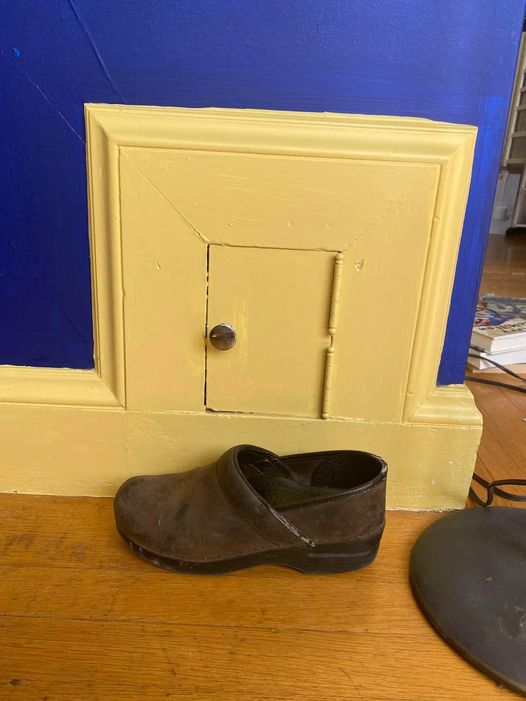Imagine moving into a house built in 1916, a place where every room seems to hold a piece of history. That’s exactly what happened to one resident, who recently shared their intriguing discovery on a social media forum, sparking a conversation about the possible purpose of a strange, tiny door in one of the bedrooms. This old house has eight bedrooms, a “sewing room” on the other side of the mystery door, and a complex layout that was well ahead of its time. But the purpose of this small door, painted over and seemingly sealed, remains a mystery.

Despite the house’s old-fashioned laundry chute system, this door appears much too small to be part of that. It’s situated in a room clearly designed as a bedroom, complete with a bathroom and closet—but neither of those features is near the small door. After thoroughly inspecting both sides of the wall, the resident couldn’t find any sign of the door’s backside in the sewing room. This led them to turn to the online community, asking, “What could this strange little feature be?”
Responses poured in, with many suggesting theories ranging from storage compartments to secret passageways. Some even wondered if it might have been an air vent or a way to pass items between rooms. The mystery has sparked curiosity not only about this particular home but also about the architecture of historical houses in general. Homes from this era often included unique, sometimes quirky, features that served various purposes—some of which have been forgotten over time.
This puzzle brings to mind the historic Spruce Hill neighborhood in Philadelphia, Pennsylvania, where Victorian architecture, designed by notable architects like George Hewitt, stands as a testament to the elegance and ingenuity of past eras. One of Hewitt’s masterpieces in this area is an iconic Victorian residence, known for its ornate design and intricate details. It embodies the opulence of its time, capturing the imagination of all who pass by with its elaborate woodwork, stained glass windows, and “gingerbread” trimmings—a term used to describe the decorative, lacy woodwork characteristic of Victorian homes. Every detail of Hewitt’s design demonstrates a dedication to craftsmanship that defined the architecture of the 19th century.
Stepping inside a home like Hewitt’s Spruce Hill Victorian reveals a seamless blend of historic charm and modern comfort. With high ceilings, detailed moldings, and rooms flooded with natural light, this home—like so many in Spruce Hill—offers visitors a glimpse into the past, complete with cozy sitting rooms and an ornately decorated parlor. Every corner of the house feels like an invitation to relive a bygone era, reminding us of the care and attention to detail that went into creating these timeless residences.
Similar to the Victorian in Spruce Hill, another historical gem, the Judge Cyrus Ball House in Tippecanoe County, Indiana, captures a different architectural style. Known as the Ball Mansion, this Second Empire estate, built in 1868–1869, is a striking example of grandeur with its towering mansard roof and intricate stone and woodwork. The Ball Mansion’s three-story entrance tower stands as a focal point, captivating visitors with its commanding presence against the Indiana landscape. Like the Victorian home in Philadelphia, the Ball Mansion serves as a tangible connection to the past, inviting people to explore its halls and imagine life in a different era.
Stepping into the Ball Mansion, one can’t help but admire the resilience of its limestone foundation and slate roof, both of which have withstood the test of time. Inside, the mansion features expansive living spaces adorned with woodwork and craftsmanship reflective of the 19th century. Standing beside the main house is the two-story carriage house, a charming reminder of a time when horse-drawn carriages were the primary mode of transport. The Ball Mansion’s historical significance goes beyond its architectural beauty; it serves as a symbol of heritage and community pride in Tippecanoe County.
Across the country, similar architectural marvels continue to capture our imaginations. Take, for example, the Old Hickory – F.W. Knox Villa, a historic estate nestled in a serene setting, celebrated for its refined design and attention to detail. Each room in this villa is a work of art, offering an immersion into the opulent lifestyles of its original inhabitants. The grand foyer, intricate woodwork, and lavish furnishings of the Old Hickory Villa speak to a level of craftsmanship that was once standard in homes of such stature. Today, the Old Hickory Villa remains a beloved landmark, preserved as a reminder of the past and a treasure for future generations.
Historical homes like these stand as reminders of the architectural creativity and cultural richness that defined earlier centuries. Each one, from the Victorian home in Philadelphia to the Ball Mansion in Indiana and the Old Hickory Villa, tells a story that transcends time. Preserving these treasures allows us to celebrate the craftsmanship of the past and the beauty that once defined American homes.
So, what’s the story behind the mystery door in the 100-year-old house? We may never know for sure, but the intrigue adds a layer of charm to this residence, much like the hidden passages, unique compartments, and secret doors of other historic homes. As we explore these architectural relics, we can’t help but marvel at the ingenuity and character that have left an enduring mark on history. The mystery door may remain locked, but it continues to capture the imagination, adding to the home’s allure as a small yet captivating part of the grand narrative of architectural history.





